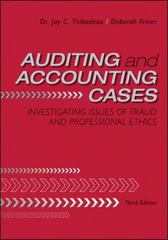ALO and New Church Ventures had no employees of their own, and both organizations paid BFA substantial
Question:
ALO and New Church Ventures had no employees of their own, and both organizations paid BFA substantial management fees to provide accounting, marketing, and administrative services. As a result, both ALO and New Church Ventures owed BFA significant amounts by the end of 1995. Overall BFA, New Church Ventures, and ALO had a combined negative net worth of \($83.2\) million at year-end 1995, \($102.3\) million at year-end 1996, and \($124.0\) million at year-end 1997.2 Related Parties Disclosure (1991–1994) In addition to its affiliates, BFA’s related parties included its subsidiaries, BFA senior management, and their immediate families, as well as any former or current members of the board of directors. Yet except for information provided about New Church Ventures in its 1994 financial statements, the transactions and balances due from the following individuals and companies were not disclosed as related parties in the financial statements for the years 1991 through 1994:
• Dwain Hoover, BFA board member.
• Harold Friend, former BFA board member.
• Jalma Hunsinger, owner of ALO, former BFA board member and New Church Ventures board member.
• ALO and its subsidiaries and affiliates.
• New Church Ventures and its subsidiaries and affiliates.3 Related Parties Disclosure (1995)
In the footnotes to BFA’s 1995 financial statements, rather than using their names, BFA described its related parties according to their titles or roles in the business. This practice made it far more difficult and time-consuming for users to identify the true related parties. For example, BFA disclosed its related parties as follows: “Director A [Dwain Hoover] and his companies”; “Benefactor A [Harold Friend] and his companies”; and “Benefactor B [Jalma Hunsinger] and his companies.” ALO was a Benefactor B company, and New Church Ventures was “a company associated with Southern Baptist causes.”4 Related Party Pseudonyms • Director A ⫽ Dwain Hoover.
• Benefactor A ⫽ Harold Friend.
• Benefactor B ⫽ Jalma Hunsinger.
• ALO ⫽ a Benefactor B company.
• New Church Ventures ⫽ a company associated with Southern Baptist causes.
BFA disclosed in Footnote 13 of its 1995 financial statements, titled “Related Parties,” that “a substantial portion of BFA’s transactions involve individuals or companies associated with Southern Baptist causes.”5 In Footnote 13 it described “some of the more significant transactions involving related parties,” including notes receivable from “Director A, Benefactor A, and Benefactor B or their companies” totaling \($8,825,063\), \($2,400,000\), and \($53,797,827\) (notes owed from ALO).
Footnote 13 did not include an additional \($37,400,000\) in notes receivable owed to BFA from New Church Ventures, which was discussed in Footnote 3 titled “Notes Receivable.”6 The footnotes to the 1995 financial statements did not disclose the material nature of the total notes receivable owed to BFA from related parties ALO and New Church Ventures, which accounted for 63 percent of BFA’s total notes receivable—or 30 percent of BFA’s total assets and more than 10 times as much as BFA’s total net assets. This substantial concentration of credit given to ALO and New Church Ventures was also not disclosed in Footnote 2 in a subsection titled “Concentration of Credit Risk,” which stated, “Concentration of credit risk with respect to notes receivable are limited due to the fact that BFA requires notes receivable to be adequately collateralized.”7 Related Parties Disclosure (1996–1997)8 In connection with its 1996 audit of BFA, Arthur Andersen commented in a memorandum on internal control structure on BFA’s lack of review, analysis, and proper documentation of related party transactions.
Andersen also criticized the fact that the collateral on related party notes receivable was not adequately monitored. It noted that “certain of the notes receivable from....
Case Questions
1. Explain why gains recorded on transactions with related parties would have greater inherent risk of being overstated in the financial statements.
2. Define what is meant by a company’s control environment. Comment on the impact that BFA’s related party disclosure practices would have on an auditor’s assessment of BFA’s control environment.
3. What is the most relevant financial statement assertion(s) about the related party transaction activity at BFA? Why? Please provide support for your answer.
4. For the assertion identified in Question 3, identify a specific internal control activity that would help prevent or detect a misstatement connected to the related party transaction activity at BFA.
Step by Step Answer:

Auditing And Accounting Cases Investigating Issues Of Fraud And Professional Ethics
ISBN: 9780078110818
3rd Edition
Authors: Jay Thibodeau, Deborah Freier





